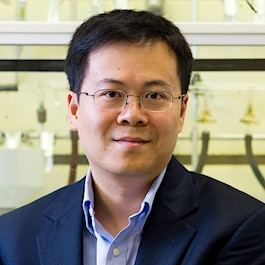Jiaxing Huang, Materials for Public Health

In 2018, Jiaxing Huang, PhD, professor of materials science and engineering at Northwestern, received a plethora of publicity for his revolutionary graphene hair dye. He made appearances on NPR and BBC “Inside Science,” received attention from Science and The New York Times, and even caught the attention of beauty magazines like Allure and Teen Vogue.
His dyes offer an alternative to those who are allergic to chemical hair dyes, and they produce better-looking shades of black color than many current products.
While his hair dye work addresses a problematic issue for many ordinary people, since the pandemic hit in 2020 Huang has applied his inventive mind to searching new material solutions that could help to impede the spread of the coronavirus.
Huang’s work related to COVID-19 has been prolific, producing three different inventions. His first technology, a self-sanitizing mask insert, received a National Science Foundation (NSF) RAPID grant. The insert is compatible with existing mask designs but provides an additional layer of protection for other people close to the wearer. The chemical layer is impregnated with antiviral agents that sanitize respiratory droplets that have escaped from the mask.
“It certainly has a protection function for the wearer, but it was meant more as a general tool for a public health campaign, to protect others,” he said. “It doesn’t cause discomfort in breathing, and you will not breathe in the antiviral agent.”
As reports came out that COVID and other respiratory viruses remained active on surfaces for several days, Huang launched a second COVID-related project aimed to address this issue. With funding from the U.S. Office of Naval Research, Huang and his students are developing a copper-containing coating that can be retrofitted onto stainless-steel products to accelerate the inactivation of viruses when droplets land on the surface.
Huang’s lab is optimizing the coatings so that they simply can be applied with a brush, saving the trouble of replacing existing stainless-steel surfaces. The applications of this coating could have an enormous public health impact if used in public places within buildings or modes of transit.
Huang’s third line of COVID-related research is focused on rethinking the protective shields, such as face shields or the Plexiglas shields used to separate people speaking to one another. He is exploring the question of whether a properly made face shield might be as good at trapping the respiratory aerosol droplets as a mask. This project has not yet been externally funded, but he is hopeful of identifying a willing industry partner.
Clearly, Huang is devoted to solving problems with material innovations. “We want to take a deep dive to understand what is the real problem, and then we design the best material solutions to solve it. It has to be problem-centered rather than inventor-centered, and simple enough to be implemented,” he said.